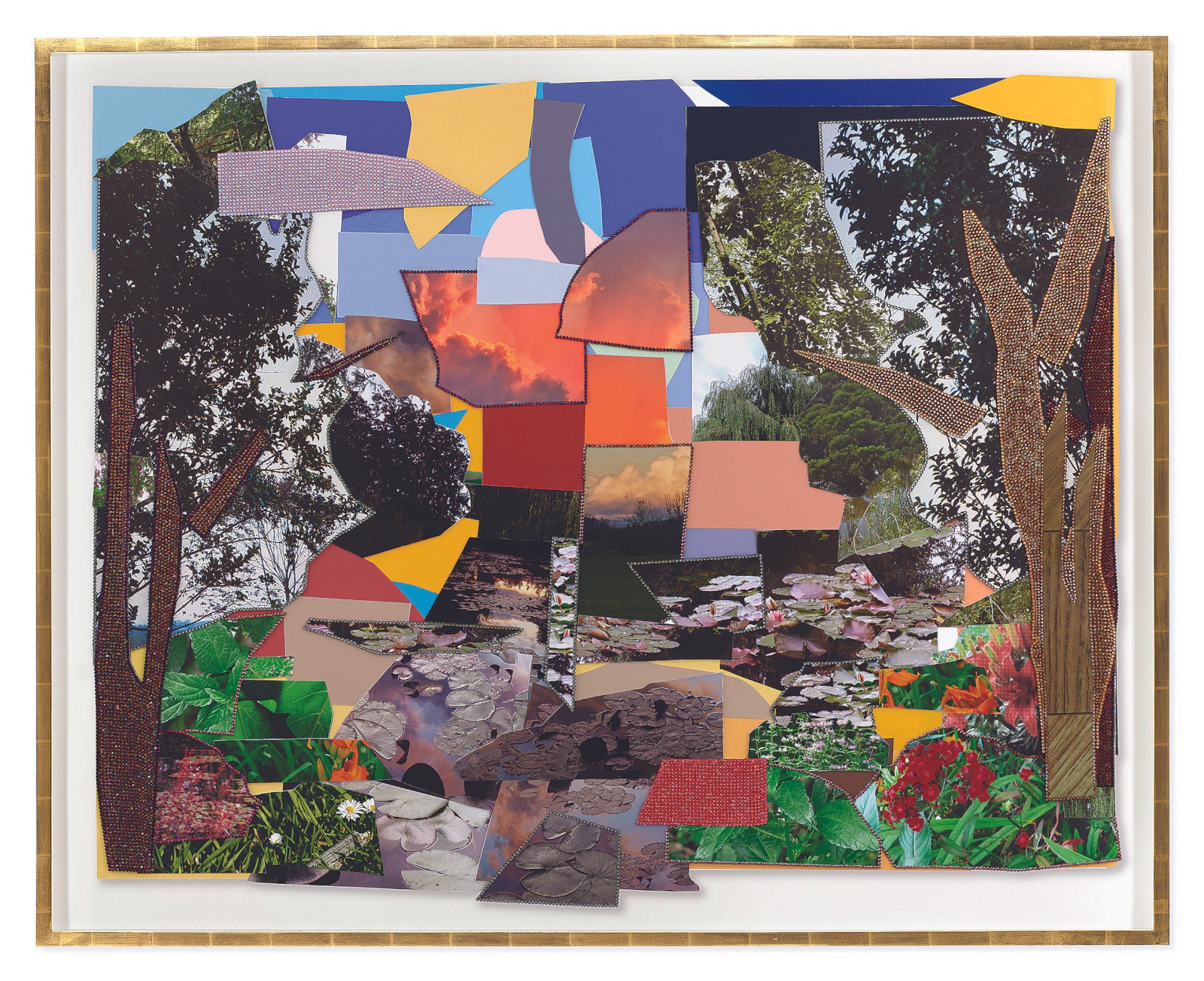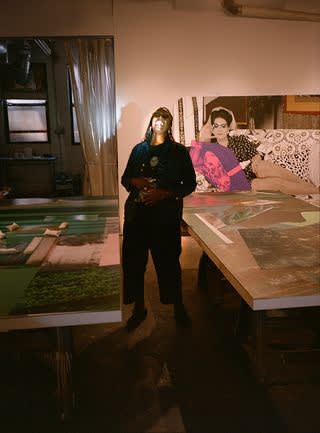
“Projecting joy is really important to me,” she says of her first big show at the Musée de l’Orangerie.
When you walk into Mickalene Thomas’s Brooklyn studio, your eye is drawn to large canvases overflowing with cheerful color. It isn’t until you get closer to the works that line the walls—many of which glimmer with rhinestones and portray in magnificent scale Black women’s daily lives—that you start to understand the current momentum behind the artist.
On an early fall day, BAZAAR.com previewed pieces that were soon to be shipped to Paris for Thomas’s self-titled show at the Musée de l’Orangerie. At the museum, located along the Tuileries Garden, not far from Monet’s Giverny estate where Thomas spent time as an artist in residence in 2012, several new works incorporating her distinct vocabulary made their debuts yesterday—marking the end of a considerably significant year for Thomas.

LUISA OPALESKY FOR MICKALENE THOMAS
Thomas’s stature as a leading figure in American art is undeniable, with her works currently in the permanent collections of major institutions like the Museum of Modern Art and the Guggenheim. In June, Thomas and Racquel Chevremont curated “Set It Off,” an exhibition featuring six female artists at the Parrish Art Museum in Water Mill, New York. And next month, the Pratt Institute, where she received her BFA, will honor her with its annual Legends Award, created to celebrate individuals who are shaping the cultural landscape (past recipients include some of the most significant names in culture, from Laurie Anderson and James Turrell to Marc Jacobs and Patti Smith).
“Projecting joy is really important to me.”
Despite the accolades, Thomas, during our talk, is focused on what’s next: her first major museum show in France. She has created three new large-scale collages, one monumental painting, and an immersive site-specific installation featuring her 2016 video/sculpture Me as Muse for the exhibition. Each piece highlights Thomas’s obsession with art history, especially the French impressionists—and repeating themes, such as critiquing the male gaze and the traditional representation of women and queerness—while remaining unrelentingly joyful.
“Projecting joy is really important to me,” Thomas tells BAZAAR. In an effort to move the conversation away from stereotypical trauma, she provides a window into happy times while challenging the historically male perspective. “There’s all of this other beauty and love and fun and adventure within the limitations that aren’t being shared.”
A commanding presence in her studio is Le Déjeuner sur l’herbe: les Trois Femmes avec Monet, one of the works in the Musée de l’Orangerie exhibition. The piece is quintessential Thomas, replacing the historic images of two clothed men dining in a park with two female nudes by Édouard Manet with three Black women. The photographs in the center are in black and white, showing the women in positions of strength, gazing directly at the viewer. Their Afros and boldly printed outfits are outlined with rhinestones on the canvas, as blocks of color and flowers frame the composition. Beyond the childlike sense of whimsy, you can clearly understand Thomas’s mission to take the old and recognizable, and provide a fresher, more personal layer of representation.
“I just love the conversation around the historical relationship between myself, Matisse, and Manet,” she says. “It was a full-circle moment of relationships and how I was looking at my art and how my art comes together.”

MICKALENE THOMAS
Similarly, Me as Muse, centers on the often-discussed subject of the odalisque in art. Thomas is reviving the piece in a site-specific garden-like environment within the Paris museum. In it, 12 stacked TV monitors show the artist reclining nude as an audio recording of Eartha Kitt describing the traumatic experiences of violence and discrimination she encountered in her life plays. As a reference to odalisques by Modigliani, Ingres, and others, the artist is discussing and reclaiming the fetishization of the female form throughout history.
During her MFA program at Yale, Thomas began examining the idea of muses and celebrities—how they inform our aspirations and personify our hopes—and the idea of muses as mentors. “You see yourself within these women and they personify you and validate who you are by what they’re doing in the world,” Thomas says. “They are giving you a platform of agency.”
“By revisiting and subverting well-known paintings of Impressionism, [Thomas] offers a complex and meaningful representation of femininity, desire, and power, which represent the breadth of her visual language,” Claire Bernardi, director of the Musée de l’Orangerie, says.

LUISA OPALESKY FOR MICKALENE THOMAS
Around the kitchen table in her studio, flanked by color-coordinated art books, Thomas says she’s overwhelmed by the opportunity she’s been given to introduce French audiences to her work, and the sentiment it will hopefully elicit: “‘Wow, this Black American girl from Camden, New Jersey, is so connected to our culture that we’re excited about that.’”
As our talk falls days before her show opening, Thomas is busy packing, sorting out last-minute exhibition details, and “ferociously” brushing up on her Duolingo, with plans to make Paris a more permanent home away from home. “I know a lot of people have a conflicted experience with Paris, but for me, I never had any, maybe because I’m so open to it in so many ways,” she says. And as she unwraps a new striped Comme des Garçons PLAY T-shirt—her new French wardrobe—it’s clear that this next chapter in her life will be filled with the same intellect and joy as the artwork she creates.

